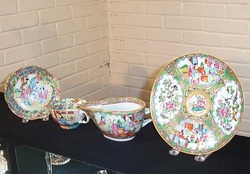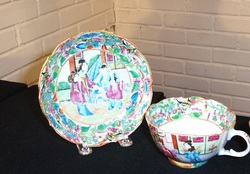- Welcome to The Wise Collector
- Knowledge Changes Everything!
- Buyer Beware!
- Buyer Beware!: Part II
- Caring for Your Antiques
- Coin Collecting
- McCoy Pottery
- Chinese Export Porcelain
- Frankoma Pottery
- The Arts and Crafts Movement
- Roycroft
- The Art Deco Period
- Susie Cooper Pottery
- Limoges China
- 18th C American Furniture Styles
- The Bauhaus School: Weimar 1919
- The Bauhaus School: Design & Architecture
- Portmeirion
- The End of a Century: Art Nouveau Style
- Biedermeier: The Comfortable Style
- The Souvenir Age
- A History of Ceramic Tiles
- Flow Blue China
- Collect Vintage Christmas Decorations
- An American Thanksgiving Through theYears
- How to Find an Antiques Appraiser
- Louis Prang, Father of the American Christmas Card
- Thomas Cook and the Grand Tours
- Harry Rinker's 25th Anniversary
- Mid-Century Modern
- Will Chintz China become Popular Again?
- Ireland's Waterford Crystal
- Vintage Wicker and Rattan
- Fishing Gear Collecting
- Bennington Pottery
- Identifying Pottery and Ceramic Marks
- The Art of Needlework in the Arts & Crafts Era
- The Delicious World of Vintage Cookbooks
- BLOG: RANDOM THOUGHTS
- E-BOOKS BY BARBARA BELL
- First Reader Consulting
Chinese Export Porcelain
Some of the most beautiful and highly collectible porcelain that can be found today, was once considered mere ballast in the holds of clipper ships plying the trade routes between China, Europe and the United States! This porcelain, now known generically as "Chinese Export," includes such patterns as Canton, Rose Medallion, Fitzhugh, and Bird and Butterfly. Chinese Export was made in China exclusively for export, between the years 1780 and 1880 and a little into the 20th century.
China had been trading with the West from as early as 200 A.D., and there are many incredible accounts (some filled with fantastic and highly fictional tales) from the rare Westerner who made the trip successfully. Marco Polo is perhaps the best-known. The Romans, the Crusaders, the Portuguese, the Russians, Swedes - all heard the stories from returned travelers and their curiosity grew. Finally the first European port was opened in Canton in 1556, and it enabled organized trade to begin.
Even before the Chinese were really aware of the "outside world," beautiful porcelain was being made for the royal family and court. Along with spices and silks, porcelain was highly profitable for the European traders. Because trading was so complicated and filled with risk, those who were successful became fabulously wealthy. The Chinese wanted gold, which to a large extent was used to bring in opium from the Near East and India. Although the Opium Wars in the first half of the 19th century closed Canton briefly, other ports opened such as Hong Kong, Shanghai, and Macao.
Porcelain was a very popular trade item in America. However, the quality of porcelain produced for trade with the West was never high enough to be acceptable to the Chinese themselves. Indeed, early export porcelain was quite heavy, perhaps to provide greater weight as non-spoiling ballast on the tall-masted clipper ships. Toward the end of the 19th century, the porcelain became lighter and more translucent yet poorer in quality, coinciding with ships turning to steam, when ballast was no longer as necessary.
The porcelain was mass-produced in standardized designs. These designs were probably created by English and American designers, who then placed orders for bulk production by Chinese "factories." Some of the patterns we are familiar with today are not Chinese in origin at all, but were first made in 18th-century England! Wealthy Europeans often ordered sets of china with their family coats-of-arms or monograms integrated into part of a standard pattern. These are very collectible today. Some patterns are polychrome, such as the Rose Medallion and Rose Mandarin patterns, and others are monochrome, such as Canton (the popular blue-and-white) and Fitzhugh (usually green).
The shapes of Chinese Export plates, pitchers and other items were taken from European silver. Blanks were taken from the inland potteries to be decorated in Canton. The classic "famille rose" red overglaze was imported from Europe.
The pattern known as Canton was made from the first quarter of the 19th century up to the end of the century. Its design consists of a large center panel with houses, mountains and a bridge, surrounded by a border, in blue on white. Early Canton is heavier, with an "orange-peel" texture, and often has strawberry finials. Later Canton is thinner and has a straight-line border. A wide gold edge added to the pattern is called Imperial Canton and is harder to find. The shade of blue varies from light to dark, and although the dark blue is more popular and thus more expensive, there is no added value - it is strictly one's taste that determines its collectibility.
Rose Medallion is the pattern with the widest variations in forms, pattern and quality. It is characterized by four alternating panels around a central gold circle ("medallion") enclosing a bird and a tree peony (the "rose" of China). Within the four panels are birds, flowers, butterflies and people in a house. Separating the panels are scrollwork vines, and flying bats, a good luck symbol.
Variations on Rose Medallion are Rose Mandarin, which shows only people; and Rose Canton, which shows only birds, flowers and butterflies (no people).
Higher quality Rose Medallion will exhibit the use of gold to highlight details in the ladies' hair, and finer, more realistic details on the birds, vines and butterflies. You will see, in comparing different pieces that the better quality ones have exquisite detail inside the medallion, and generally will be heavier.
The Butterfly pattern is easy to distinguish, as it has butterflies throughout the pattern. The shapes are the same as Canton, but without as many types. This was mostly produced mid-century, and is very colorful.
Other patterns you may find are Cabbage, Green Dragon, Sacred Carp, Sacred Flower and 100 Antiques. Nanking, a variation of Canton, is more refined in execution, and usually shows people standing on a bridge, which is not part of the Canton pattern.
The Fitzhugh pattern consists of four groups of flowers or plants spaced evenly around a central circle. In the circle there often was a coat of arms, an initial, or a scenic view.It is usually monochromatic, appearing appearing in green, blue, yellow, black or orange.
As was typical of Victorian taste, nearly every use possible was answered in a shape or piece in Chinese Export porcelain. Garden seats, shaving mugs, baby plates, cider jugs, tea sets, coffee sets, toothbrush holders, punch bowls, paintbrush boxes, candlesticks, syllabub cups, ginger jars, eggcups, and platters are just a few forms that can be found. Tea and coffee pots came in a wide assortment of shapes.
If you collect any of these beautiful patterns of Chinese Export porcelain, be aware that the first investigation you make should be the mark on the bottom of the piece. After 1891, all items imported into the United States had to show the country of origin. A piece marked "Made in China" or "Decorated in Hong Kong" for example, indicates that it is a later piece. Some reproductions may say "Made in Japan"! A very poor reproduction, recognizable by the careless black paint strokes and orangey color, is known as "Geisha Girl" and was made in Japan after World War II.
The best way to learn the distinguishing characteristics of good quality Chinese Export porcelain is to learn from an expert. When you see pieces in a shop or a show, ask questions! A reputable dealer will be happy to point out the things you should know. Begin your collection with simple cups and saucers, or little plates called "nappies", and as you gain knowledge, add to your collection. It will give you years of pleasure!
Recently I was sent a link to an article about the lucrative business of "faking" Chinese Export porcelain. The article appears in Antiques Magazine, and is written by Shirley Mueller. Please go to "Using Science to Unmask Fake Order of the Cincinnati Decoration on Chinese Export Porcelain" for more information.
Web Hosting by iPage. The copyright of the articles in The Wise Collector is owned by Barbara Nicholson Bell. Permission to republish any articles herein online or in print must be granted by the author in writing.

